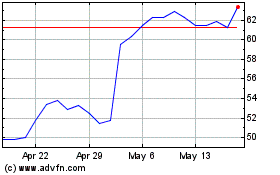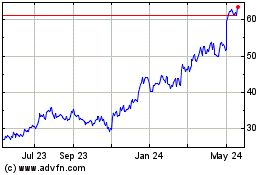New report reveals combating payment fraud,
strengthening client relationships and enhancing commercial banking
experience are top trends for financial institutions
Q2 Holdings, Inc. (NYSE:QTWO), a leading provider of digital
transformation solutions for financial services, announced today it
has released its State of Commercial Banking January 2025 Market
Analysis report. Key findings from the annual report reveal major
trends in the commercial banking industry, in addition to the
challenges and opportunities banks and credit unions will face in
the coming year.
“The commercial banking industry demonstrated resilience and
adaptability in 2024, successfully rebuilding liquidity to near
pre-crisis levels,” said Q2’s Senior Strategic Business Advisor
Gita Thollesson. “2025 will present its own challenges and
opportunities, including combating payment fraud and strengthening
primacy in a competitive digital landscape. For banks and credit
unions to maintain their edge, they should strategically leverage
digital offerings to enhance profitability and meet customer
demands for efficiency and innovation.”
This report is based on findings from Q2 PrecisionLender’s
proprietary database of 2024 commercial lending deal flow, along
with economic data from several public sources, including the
Federal Deposit Insurance Corporation (FDIC) and Federal Reserve,
and industry research. Q2 PrecisionLender data reflects commercial
relationships from more than 140 geographically diverse banks and
credit unions in North America, ranging in size from small
community banks to top 10 U.S. institutions. This report also
references data from Q2’s Centrix Exact TMS positive pay solution
and live polling conducted during Q2 webinars in 2024.
Key Takeaways from the Report:
- Liquidity has improved but has become more costly, squeezing
net interest margins – Financial institutions have emerged from
the liquidity crisis with a solid foundation of deposits,
approaching pre-crisis levels.
- Federal Reserve rate cuts have reshaped the commercial loan
pricing landscape – The 100 basis points in Federal Reserve
rate cuts between September and December 2024 contributed to a
shallowing of the inverted yield curve, with short-term rates
declining while mid-term rates spiked.
- Pockets of credit stress reside in the commercial real
estate sector – Credit performance has exceeded expectations
across much of the market, with only a modest increase in
delinquencies and a decline in commercial and industrial (C&I)
downgrades.
- Fraud continues to concern bank and credit union executives
– By embracing collaboration, advanced technologies like AI,
and a centralized approach, banks and credit unions can be a strong
ally for business customers in the ongoing battle against
fraud.
- Data and digital technology drive the acquisition and growth
of small business relationships – The underserved small and
medium-sized business (SMB) market presents an opportunity for
banks and credit unions to grow deposits.
- Efficiency and user experience are becoming even more
pivotal for midsize and large companies – Commercial clients
are looking to their banks and credit unions to help them manage
their business more efficiently.
Click here to download the 2025 State of Commercial Banking
Market Analysis report.
For additional insights related to the report, listen to Q2
senior strategic business advisor and report co-author Anna-Fay
Lohn’s episode on The Purposeful Banker podcast, and watch the
recording of Q2’s annual State of Commercial Banking webinar.
To learn more about how Q2 delivers simple, smart, end-to-end
banking and lending solutions for commercial financial
institutions, visit https://www.q2.com/commercial.
About Q2 Holdings, Inc.
Q2 is a leading provider of digital transformation solutions for
financial services, serving banks, credit unions, alternative
finance companies, and fintechs in the U.S. and internationally. Q2
enables its financial institutions and fintech customers to provide
comprehensive, data-driven digital engagement solutions for
consumers, small businesses and corporate clients. Headquartered in
Austin, Texas, Q2 has offices worldwide and is publicly traded on
the NYSE under the stock symbol QTWO. To learn more, please visit
Q2.com. Follow us on LinkedIn and X to stay up to date.
Forward-looking Statements
This press release and the report referenced herein contains
forward-looking statements, including statements about: anticipated
challenges and opportunities in 2025, including combating payment
fraud and strengthening primacy in a competitive digital landscape;
requirements for financial institutions to remain competitive;
improved liquidity, with increased costs and tighter net interest
margins; the effects of interest rate cuts on commercial lending;
credit stress levels across the market; increased fraud and ways to
combat it; opportunities for data and digital technology within the
SMB market; and, the increased importance of efficiency and user
experience. The forward-looking statements contained in this press
release are based upon our historical performance and our current
plans, estimates, and expectations and are not a representation
that such plans, estimates or expectations will be achieved.
Factors that could cause actual results to differ materially from
those described herein include risks related to: (a) global
economic uncertainties and challenges or changes in the financial
services industry and credit markets, including as a result of
recent bank failures, mergers and acquisitions within the banking
sector, inflation, higher and shifting interest rates and any
potential financial regulations and their potential impacts on our
prospects' and customers' operations, the timing of prospect and
customer implementations and purchasing decisions, our business
sales cycles and on account holder or end user, or End User, usage
of our solutions; (b) the risk of increased or new competition in
our existing markets and as we enter new markets or new segments of
existing markets, or as we offer new solutions; (c) the risks
associated with the development of our solutions, including
artificial intelligence, or AI, based solutions, and changes to the
market for our solutions compared to our expectations; (d)
quarterly fluctuations in our operating results relative to our
expectations and guidance and the accuracy of our forecasts; (e)
the risks and increased costs associated with managing growth and
global operations, including hiring, training, retaining and
motivating employees to support such growth, particularly in light
of recent macroeconomic challenges, including increased competition
for talent, employee turnover, labor shortages and wage inflation;
(f) the risks associated with our transactional business which are
typically driven by End User behavior and can be influenced by
external drivers outside of our control; (g) the risks associated
with effectively managing our business and cost structure in an
uncertain economic environment, including as a result of challenges
in the financial services industry and the effects of seasonality
and unexpected trends; (h) the risks associated with geopolitical
uncertainties, including the heightened risk of state-sponsored
cyberattacks or cyber fraud on financial services and other
critical infrastructure, and political uncertainty or discord,
including related to the 2024 U.S. presidential election; (i) the
risks associated with accurately forecasting and managing the
impacts of any economic downturn or challenges in the financial
services industry on our customers and their End Users, including
in particular the impacts of any downturn on financial technology
companies, or FinTechs, or alternative finance companies, or
Alt-FIs, and our arrangements with them, which represent a newer
market opportunity for us, a more complex revenue model for us and
which may be more vulnerable to an economic downturn than our
financial institution customers; (j) the challenges and costs
associated with selling, implementing and supporting our solutions,
particularly for larger customers with more complex requirements
and longer implementation processes, including risks related to the
timing and predictability of sales of our solutions and the impact
that the timing of bookings may have on our revenue and financial
performance in a period; (k) the risk that errors, interruptions or
delays in our solutions or Web hosting negatively impacts our
business and sales; (l) the risks associated with cyberattacks,
financial transaction fraud, data and privacy breaches and breaches
of security measures within our products, systems and
infrastructure or the products, systems and infrastructure of third
parties upon which we rely and the resultant costs and liabilities
and harm to our business and reputation and our ability to sell our
solutions; (m) the difficulties and risks associated with
developing and selling complex new solutions and enhancements,
including those using AI with the technical and regulatory
specifications and functionality required by our customers and
relevant governmental authorities; (n) risks associated with
operating within and selling into a regulated industry, including
risks related to evolving regulation of AI and machine learning,
the receipt, collection, storage, processing and transfer of data
and increased regulatory scrutiny in financial technology and
related services, including specifically on banking-as-a-service,
or BaaS, services; (o) the risks associated with our sales and
marketing capabilities, including partner relationships and the
length, cost and unpredictability of our sales cycle; (p) the risks
inherent in third-party technology and implementation partnerships
that could cause harm to our business; (q) the risk that we will
not be able to maintain historical contract terms such as pricing
and duration; (r) the general risks associated with the complexity
of our customer arrangements and our solutions; (s) the risks
associated with integrating acquired companies and successfully
selling and maintaining their solutions; (t) litigation related to
intellectual property and other matters and any related claims,
negotiations and settlements; (u) the risks associated with further
consolidation in the financial services industry; (v) the risks
associated with selling our solutions internationally and with the
continued expansion of our international operations; and (w) the
risk that our debt repayment obligations may adversely affect our
financial condition and that we may not be able to obtain capital
when desired or needed on favorable terms.
Additional information relating to the uncertainty affecting the
Q2 business is contained in Q2's filings with the Securities and
Exchange Commission. These documents are available on the SEC
Filings section of the Investor Relations section of Q2's website
at http://investors.Q2.com/. These forward-looking statements
represent Q2's expectations as of the date of this press release.
Subsequent events may cause these expectations to change, and Q2
disclaims any obligations to update or alter these forward-looking
statements in the future, whether as a result of new information,
future events or otherwise.
View source
version on businesswire.com: https://www.businesswire.com/news/home/20250130547921/en/
MEDIA CONTACT Carly Baker Q2 Holdings, Inc. +1
210-391-1706 Carly.baker@q2.com
Q2 (NYSE:QTWO)
Historical Stock Chart
From Jan 2025 to Feb 2025

Q2 (NYSE:QTWO)
Historical Stock Chart
From Feb 2024 to Feb 2025
